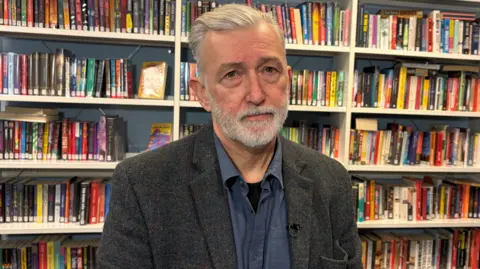Katy McCloskeyBBC Scotland
 Getty Images
Getty ImagesScotland’s teachers are readying themselves to vote on industrial action over their workload and the amount of time they actually spend in front of a class.
They say it is almost five years since the SNP’s election manifesto promise to cut class contact time by 90 minutes a week to give teachers more time for activities such as lesson preparation and marking.
Union bosses say teachers are under unprecedented pressure, suffering from snowballing demands, ever increasing workloads and, in many cases, burnout.
The situation is not new but teachers have told the BBC it is getting worse, particularly due to an increase in children with additional support needs.
Scotland’s largest union, the EIS, begins its postal ballot on Wednesday, while the NASUWT will begin its vote from 19 November. The SSTA is expected to ballot members soon.
What would teachers do with an extra 90 minutes?

Most teachers will not speak to the media on the record over concerns that their contracts won’t allow it.
However, the BBC has spoken to a number of teachers who are also union reps.
Rod McCready is an NASWUT rep and physics teacher in Glasgow who has been teaching more than 20 years.
He says that, for his subject, marking is easier than for others but he needs extra time to plan lessons better.
“Physics can be a complicated topic,” he says.
“You need half a dozen ways to help explain something and you are waiting for one of those ways to click with a kid, to pursue that.”
He says not everyone is suited to the classroom.
“There was a teacher last year who chucked it after three weeks, it was too difficult,” he says.
“I was lucky I landed in a good school. In my job as a union rep, I hear about violence and aggression in the classroom, the pressure it’s causing is unbelievable.
“If you get pushed against a wall, that’s 20 minutes to 40 minutes just to fill in the paperwork.”

Derrick Roberts, who teaches history in the Lochaber area, says he would spend the extra hour-and-a-half from cutting contact time on adapting lessons for children with additional needs.
He says he currently finds himself doing work at home most evenings.
“Sometimes I’m rushing lessons in the evening and at the weekends trying to get things done,” he says.
“The 90 minutes would allow me to adapt materials – changing the resources so they fit in the right place.
“I’ve got my bank of resources but I don’t have sufficient time to adapt them.”
Mr Roberts says he felt less pressured when he first came to Scotland 13 years ago.
“We were expected to do less of the non-teaching stuff,” he says.
“We weren’t being chased for every piece of data, we didn’t need to know three or four things about every pupil.”
He says that when he came to Scotland teachers would not normally be hitting the 22.5 hour limit for contact time and would often have one or two periods a week where they could catch up.
Now he says there is a recruitment and retention crisis, not enough supply teachers, more posts unfilled and more “please takes”, where teachers are asked to fill in for colleague.
He says more staff are now teaching up to the current limit of 22.5 hours.
“An extra 90 minutes a week would allow a wee buffer zone,” he says.

Carol Wood is an ASN (additional support needs) teacher in a specialised unit within a mainstream secondary school in Moray.
She says she would use her extra time to get on top of the paperwork which comes with the job.
“There is a lot of admin in ASN,” she says.
“There’s learning support plans, learner plans, individual education plans.
“You need to go and observe kids, then write a STAR report.
“The extra time would support much more effective understanding of these pupils which would help mainstream colleagues understand them better,” she says.
Ms Wood says she would also like to do more training.
“I’d go look at webinars to see the latest research,” she says.
“It’s all moving so fast at the moment with the neurodivergent discovery journey and just having that time to digest the new materials and processes would be great.”
According to Ms Wood, she has children in secondary school whose development is similar to primary level.
She says she can take hours tailoring worksheets to their needs only for it to occupy a pupil for 20 minutes.
“Every child in my class, every single one is different, has a different need or take,” she says.

Alison Beattie works in “support for learning” within a mainstream primary school in Glasgow.
She takes children out of the classroom to help them with their learning, either one- to-one or in groups.
“However, I’m the first person for cover when there is an absence, meaning I’ve had six full days of learning support since August,” she says.
“It’s frustrating because I’d rather be working with children.
“If I got the extra time, I’d spend it on paperwork and talking to colleagues about support needs.”
Alison says the number of children in her primary school with additional support needs has rocketed from 11% two years ago to 60% in May this year.
She says she can see that figure reflected in how things have changed.
“That figure is realistic,” she says.
“That’s my experience, that’s the needs that are presenting in front of us.
“Maybe a few years ago it perhaps wasn’t as urgent, it would have been nice to have 90 minutes then, but it’s urgent now.”
Alison says there is a range of needs within her school.
“We’ve got kids with dyslexia, dyscalculia, autism, ADHD, attachment needs,” she says.
“There’s also children with a large range of ability.
“In one classroom you could be teaching different levels.
“In P5, P6 and P7, you’ll now be teaching kids at P1 level as well as P5 level and you are expected to have lessons that meet all of those needs.”
Teacher numbers down on 2021
In 2021, the SNP pledged to increase teacher numbers by 3,500 over the course of the parliamentary term, which unions said was vital in meeting the commitment to deliver an extra 90 minutes of non-teaching time per week.
Back then, there were 54,285 teachers in Scotland. Last year, the figure stood at 53,412.
First Minister John Swinney has pledged to get numbers back to 2023 levels – 54,033 – so all eyes will be on the annual teacher census statistics when they are released next month.
Education experts point out that schools need more staff but they also need to be in the right place in order to provide cover for colleagues using their additional non-contact time.
There are also long-standing challenges with filling teaching posts in some rural areas and in some secondary specialisms.
Teachers are currently allocated seven-and-a-half hours a week of preparation time.
In the end, it is councils who employ teachers and therefore control the numbers.
The Scottish government only has so many levers it can apply to force councils to hire more staff.
Additional funding required
A spokesperson for Cosla, the group that represents local authorities, said it was disappointed that the teaching unions were progressing their consultative ballots.
They said there were practical issues with the delivery of the reduction in class contact time and it would require additional funding to support such a major change.
A Scottish government spokesperson said: “Ministers have been clear that reducing class contact will help support the time and space necessary for teachers, to allow them to drive improvement and reform in our schools and improve outcomes for their pupils.
“We are committed to working with teaching unions and Cosla to agree our approach to delivering a reduction in class contact time at pace.
“Ministers respect union members’ right to withdraw their labour, but are disappointed that the EIS has taken this action while these constructive discussions are ongoing.”
Disclaimer : This story is auto aggregated by a computer programme and has not been created or edited by DOWNTHENEWS. Publisher: BBC








